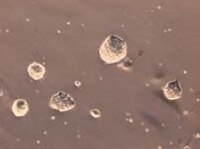Dynamic transcriptional events in embryonic stem cells mediated by the super elongation complex (SEC).
Lin C. et al.
Genes Dev.
25(14)
1486-1498
2010
Show Abstract
Transcriptional regulation of developmentally controlled genes is at the heart of differentiation and organogenesis. In this study, we performed global genomic analyses in murine embryonic stem (ES) cells and in human cells in response to activation signals. We identified an essential role for the ELL (eleven-nineteen lysine-rich leukemia gene)/P-TEFb (positive transcription elongation factor)-containing super elongation complex (SEC) in the regulation of gene expression, including several genes bearing paused RNA polymerase II (Pol II). Paused Pol II has been proposed to be associated with loci that respond rapidly to environmental stimuli. However, our studies in ES cells also identified a requirement for SEC at genes without paused Pol II, which also respond dynamically to differentiation signals. Our findings suggest that SEC is a major class of active P-TEFb-containing complexes required for transcriptional activation in response to environmental cues such as differentiation signals. | 21764852
 |
HDAC1 regulates pluripotency and lineage specific transcriptional networks in embryonic and trophoblast stem cells.
Kidder B. L. & Palmer S.
Nucleic Acids Res.
1-15
2010
Show Abstract
Epigenetic regulation of gene expression is important in maintaining self-renewal of embryonic stem (ES) and trophoblast stem (TS) cells. Histone deacetylases (HDACs) negatively control histone acetylation by removing covalent acetylation marks from histone tails. Because histone acetylation is a known mark for active transcription, HDACs presumably associate with inactive genes. Here, we used genome-wide chromatin immunoprecipitation to investigate targets of HDAC1 in ES and TS cells. Through evaluation of genes associated with acetylated histone H3 marks, and global expression analysis of Hdac1 knockout ES and trichostatin A-treated ES and TS cells, we found that HDAC1 occupies mainly active genes, including important regulators of ES and TS cells self-renewal. We also observed occupancy of methyl-CpG binding domain protein 3 (MBD3), a subunit of the nucleosome remodeling and histone deacetylation (NuRD) complex, at a subset of HDAC1-occupied sequences in ES cells, including the pluripotency regulators Oct4, Nanog and Kfl4. By mapping HDAC1 targets on a global scale, our results describe further insight into epigenetic mechanisms of ES and TS cells self-renewal. | 22156375
 |
A critical appraisal of factors affecting the accuracy of results obtained when using flow cytometry in stem cell investigations: where do you put your gates?
Hughes O. R. et al.
Cytometry A
75(9)
803-810
2009
Show Abstract
Flow cytometry is used extensively in stem cell investigations but there is wide variation in the methods used for data analysis between laboratories. Data analysis can be challenging in stem cell biology as there is often no clear distinction between positive and negative populations. We have undertaken a critical appraisal of factors that affect the accuracy of results in stem cell applications. We used mouse embryonic stem cells and determined the expression of three common antigens in stem cell investigations, namely CD15, CD184, and c-kit. We have compared different cell preparation methods and gating strategies and also evaluated the use of isotype controls and unstained cells as controls for the identification of positive populations. The use of a "doublet discriminator" using a side scatter area signal versus side scatter height signal dot plot to identify single cells for analysis increases the accuracy of results regardless of the method used to dissociate cells. Isotype controls can be helpful in mimicking cellular nonspecific binding of the experimental antibody reaction. Isotype controls behave differently on stem cells at different stages of differentiation. Analysis of a viable single cell population with careful selection of control cell populations increases the accuracy of results. | 19562683
 |











